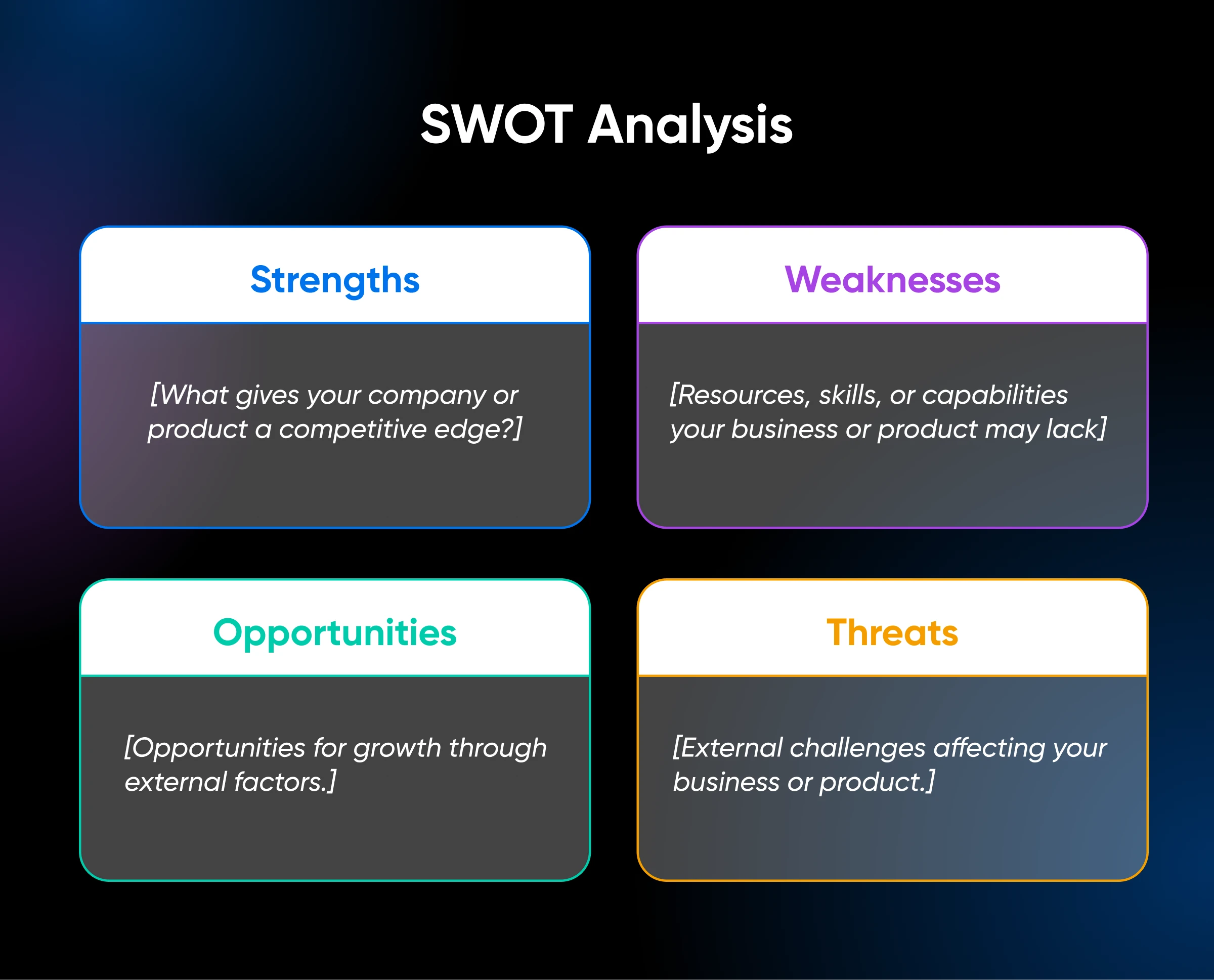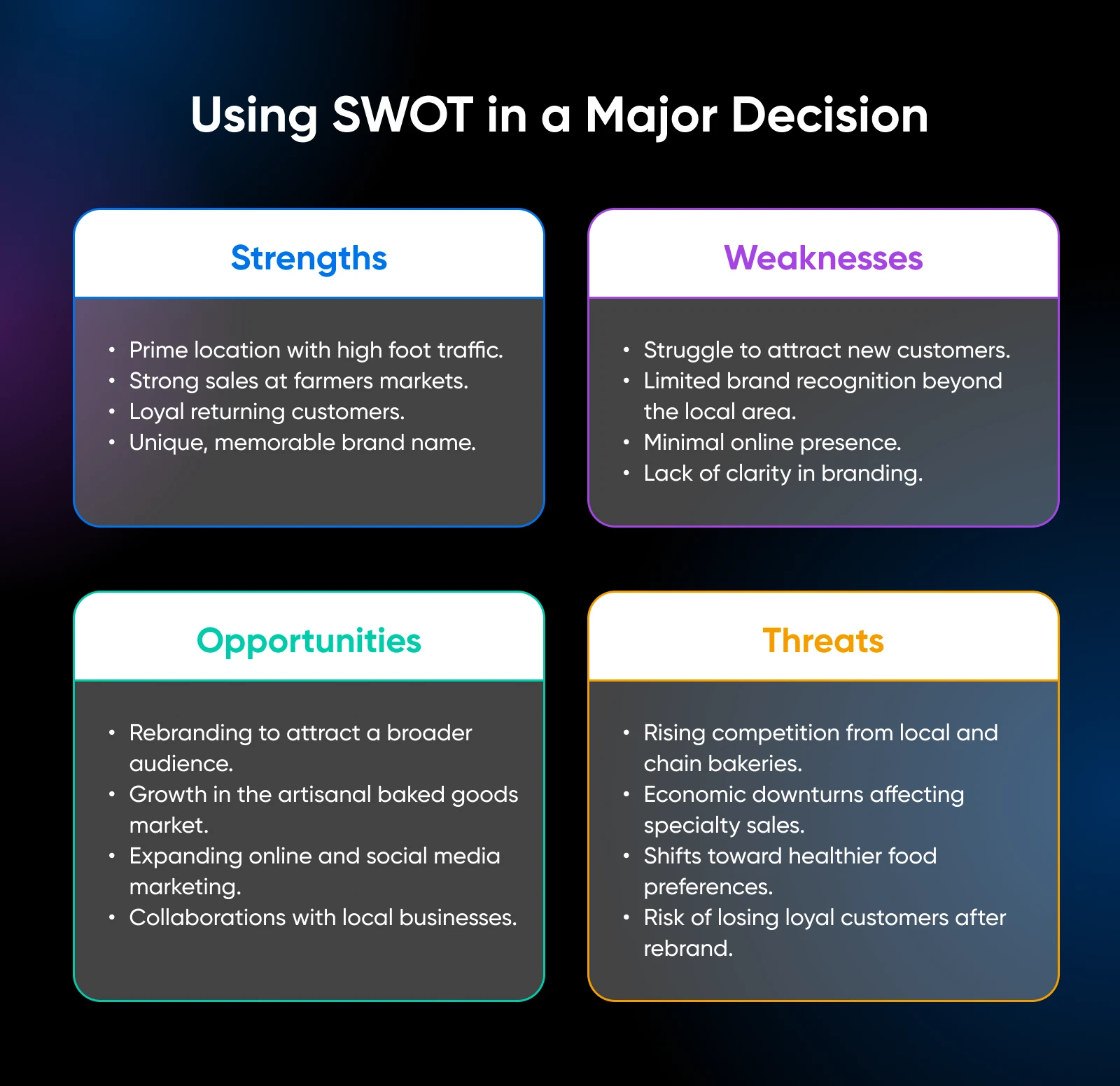Ever feel like your business is stuck in a rut, no matter how hard you try to push forward? It’s like you’re driving with one foot on the gas and the other on the brake. You can’t move forward. You can’t move backward. What do you do?
Cue the montage music because this is a great time for some inward reflection.
When your business needs a push in the right direction — or a pivot toward a new one — it’s time to sit down and think about where you’ve been and where you’re going. But without any sort of structure, reflection can feel overwhelming and unproductive.
Enter: the SWOT analysis, a tool business owners have been using for decades to better understand themselves, their teams, and their companies.
But here’s the kicker: A SWOT analysis isn’t just a theoretical exercise. When used correctly, it can be a strategic power-up to fine-tune your business strategy. A SWOT can put you on the right path to turn insights into action, helping you pivot with precision and confidence.
Thinking about launching a new product? Facing fierce competition? Or maybe you’re just looking to freshen up your brand’s image? Whatever the scenario, now might be the perfect time to dive into a SWOT analysis. Let’s uncover how you can conduct one and leverage it to transform your business strategy.
What Is a SWOT Analysis?
A SWOT analysis is a strategic planning tool that helps businesses identify their internal strengths and weaknesses and their external opportunities and threats.
By systematically evaluating these four components, a business can gain a comprehensive understanding of its current position and develop strategies to leverage its strengths, mitigate its weaknesses, capitalize on its opportunities, and guard against its threats.
A SWOT analysis can be an invaluable tool for strategic decision-making because it provides a clear, structured approach to assessing factors that can impact a business’ success.
What Is a SWOT Analysis Used For?
You can use a SWOT for many different purposes. It can help businesses or their stakeholders:
- Make informed decisions
- Guide planning sessions
- Start a new business
- Develop strategies to enhance their competitive advantage
- Identify areas for improvement and growth
- Understand market trends or potential challenges
- Make informed decisions about resource allocation
- Create contingency plans to address potential risks
- And much more
A SWOT analysis is a great tool to employ when launching a new product, entering a new market, considering a shift in business operations, or stepping into any other period of change or uncertainty.
Components of a SWOT Analysis
The SWOT matrix provides a framework for assessing both the internal and external factors that affect a business. Let’s break it down into its components.

Strengths
Strengths are the internal attributes and resources that give your business a competitive edge. Think: unique selling propositions, specialized skills, strong brand reputation, or efficient processes.
Example: A local bakery’s strength might be its use of high-quality, locally sourced ingredients, which sets it apart from larger chains.
Weaknesses
Weaknesses are internal factors that hinder your business’s ability to compete effectively. These can be areas where your business lacks resources, skills, or capabilities.
Example: The same bakery might identify a weakness in its website and limited online presence, which restricts its ability to reach a broad audience.
Opportunities
Opportunities are external factors your business can capitalize on to grow or improve. These can include market trends, changes in consumer behavior, technological advancements, or regulatory changes, to name a few.
Example: An opportunity for the bakery could be the growing trend of consumers seeking out gluten-free and vegan options, presenting the chance to expand its menu and try new flavors and offerings.
Threats
Threats are external challenges that could negatively impact your business, like economic downturns, increased competition, changes in regulations, or shifts in consumer preferences.
Example: A threat to the bakery could be a new, well-loved competitor opening a second location just down the street, which could draw away customers.
The SWOT Table
A SWOT table is a visual representation of the analysis, organized into a grid format. This is the most common way of presenting the SWOT framework. It looks like this:
| Strengths | Weaknesses |
| Opportunities | Threats |
When To Conduct a SWOT Analysis
A SWOT analysis is a powerful tool to use at various stages of a business’s lifecycle and provides opportunities for improvement and growth. Here are some specific instances when a business might consider conducting an analysis to turn weaknesses and threats into strengths and opportunities:
- When doing quarterly or annual planning: Regularly incorporating SWOT into your planning processes can help you stay aware of your business’s current strengths and weaknesses, make key decisions, and adapt to changing market conditions.
- When launching a new product or service: Before introducing a new product or service, use a SWOT analysis to understand the internal and external factors that could impact its success.
- When entering a new market: When expanding into a new market, use SWOT to identify potential opportunities and threats facing your business in uncharted waters.
- When facing increased competition: When new competitors enter the market, or existing ones become more aggressive, a SWOT analysis helps you identify ways to strengthen your competitive position.
- When experiencing business challenges: If your business is facing declining sales, operational inefficiencies, or other significant challenges, use a SWOT analysis to narrow down the root causes and identify potential solutions.
- When seeking investment or partnership: Create a SWOT analysis to gain a more comprehensive overview of your business’ position, making it easier to communicate your business plan and value proposition to potential investors or partners.
How To Know You Should Perform a SWOT Analysis
Deciding when to use SWOT can be challenging. Here are some indicators that it might be the right time for your business or team:
- You’re uncertain about which direction to go: If you’re unsure about the next steps for your business, a SWOT analysis can provide clarity by identifying areas of strength and opportunities for growth, as well as threats and weaknesses to address.
- You’re seeing significant changes in the market: A SWOT analysis reveals how industry changes, like new regulations or technological advancements, impact your business environment.
- Your growth has stagnated: If your company has hit a plateau, use SWOT analysis to identify strengths, opportunities for expansion, and areas that need improvement.
- You’re preparing for a major decision: Before mergers, acquisitions, or rebranding a good SWOT analysis helps you consider all the necessary angles and factors.
For example, let’s say our hypothetical bakery, Bread Zeppelin is considering rebranding. Here’s what their SWOT may look like:

A simple litmus test for determining whether your business would benefit from conducting a SWOT is to ask: “Are we fully aware of our internal capabilities, external threats, and environment?”
If the answer is no (or if there are any doubts), you’ll likely benefit from a SWOT.
How To Conduct a SWOT Analysis in 5 Steps
Conducting a comprehensive SWOT analysis requires more than just filling out the matrix. You need to thoroughly examine all aspects of your business and its environment.
Use this step-by-step guide to get started, and stick around for some extra tips and a free SWOT analysis template at the end.
1. Determine Your Objective or Goals
Begin by clearly defining the objective of your SWOT analysis. What specific goal or decision do you want to inform? Having a clear objective for the analysis guides the process and helps you identify success metrics.
2. Gather Data and Other Resources
Next, gather relevant data and resources for your analysis. This can include:
- Financial reports
- Customer feedback
- Market research
- Competitive analysis
- Human resources and other internal data
- Personal SWOT analyses done by participating team members
Having comprehensive data is helpful in identifying opportunities and threats as you create your SWOT. It can help guide your team when brainstorming the elements of a SWOT analysis in the next step.
3. Start Brainstorming
Engage your team in brainstorming sessions to identify internal and external factors that impact your business. Find some explanations and questions to guide your brainstorming in the SWOT analysis example below:
| Strengths: Strengths are things your business does well that give you an advantage over your competitors. Questions to Ask: What unique resources do we have that our competitors lack? What positive feedback do we consistently receive from our customers? | Weaknesses: Weaknesses are inherent features of your organization that are likely to hold you back. Questions to Ask: Where do we receive the most customer complaints? What internal processes cause delays or inefficiencies? |
| Opportunities: Opportunities are chances for your business to grow or succeed, but you’ll have to take advantage of them. Questions to Ask: Are there emerging trends that we can take advantage of? What new market segments can we target with our existing products? | Threats: Threats are external factors that can negatively impact your business from the outside. Questions to Ask: What external factors could negatively impact our sales? Are there potential regulatory changes that could affect our business model? |
4. Refine Your Findings
After your brainstorming session, refine your findings to focus on the most impactful elements. The SWOT analysis identifies key areas within the components of SWOT — Strengths, Weaknesses, Opportunities, and Threats — relevant to your business objectives.
Further refining your findings may mean performing a gap analysis to find discrepancies between your current state and desired outcomes. Your SWOT analysis may also uncover other areas that warrant further investigation.
5. Convert Your SWOT Into a Strategic Plan
The final step is to convert your SWOT insights into a plan aligned with your goals from Step 1.
Opportunities might present new avenues for launching a product or service you hadn’t considered. Additionally, consider how threats could impact your plans to expand into new markets and develop strategies to mitigate the risks.
Integrate your SWOT findings into a business case that outlines clear, actionable steps to enhance your overall performance and achieve your strategic objectives. If you use the analysis to work toward or meet your goals, your SWOT can be considered a success.
How Can a SWOT Analysis Benefit a Company or Team?
A SWOT analysis provides a comprehensive understanding of your business’s strengths, weaknesses, opportunities, and threats. The benefits of SWOT analysis include guiding your company or team to make informed decisions, optimize strategies, and achieve your business goals.
A SWOT analysis also helps you uncover potential areas for growth and improvement to gain a competitive edge.
What Are Some Common SWOT Analysis Mistakes?
While a SWOT can be incredibly beneficial, there are common pitfalls to try to avoid.
One major mistake is the misuse of SWOT analysis, such as not involving the right stakeholders or failing to update the analysis regularly. Another issue is analysis paralysis, where overanalyzing data leads to indecision and inaction.
It’s also important to recognize the limitations of SWOT analysis. For example, it may not capture all external factors as thoroughly as a PEST analysis (political, economic, social, and technological factors). By being aware of these common mistakes, you can get the most out of SWOT and other types of analysis.
Other SWOT Analysis Tips and Best Practices
- Make sure your SWOT analysis covers all relevant business areas and involves input from key team members. This will help maximize opportunities and provide a well-rounded perspective.
- Regularly update your SWOT to reflect changes in your business environment and internal dynamics.
- Use your SWOT findings to inform planning and decision-making, leverage your strengths, and address your weaknesses.
Download: SWOT Analysis Template
Now that you’ve read our guide to SWOT analysis, you’re ready to start your own.
Download our free template to make sure your SWOT analysis includes all the right components — and refer back to the SWOT examples in this article to see how to apply the analysis in different contexts.
Download our SWOT template today to start uncovering insights and driving your business forward.

Get More Visitors, Grow Your Business
Our marketing experts will help you earn more traffic and convert more website visitors so you can focus on running your business.
Learn More
